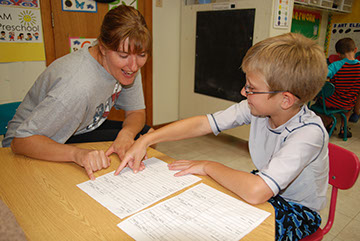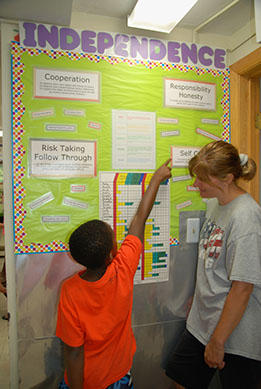School Age - Social Emotional
Independence – What does it mean for a school ager?
Independence at MCC’s School Age Program means developing an awareness of one’s strengths and weaknesses, and developing the capacity to set goals and evaluate one’s behavior.
Why do we have an Independence Program?
• To provide children with a clear set of values.
• To teach children to think independently and to make decisions for themselves.
• To establish a trusting relationship with each child through a collaborative process.
How do we teach these skills?
• Our program has a clear set of established values; we call these our primary behaviors. These include cooperation,
honesty and responsibility, self-control, follow through and risk-taking.
• We identify the strengths and weaknesses of each child by looking at their behavioral context; this allows us to see the
whole child and make comparisons across various situations.
• Children participate in color meetings with their peers to discuss their strengths and what they might work on. Through
this process children learn to set a goal by choosing a behavior they are likely to succeed in improving.
• Children’s behaviors are reinforced through extrinsic and intrinsic rewards.
Teacher support, our color chart, and privileges rooted in an increase of social skills
encompass our extrinsic rewards. More importantly, it is the intrinsic reward
stemming from the children’s pride that leads to sustained behavior change.
We are guided by the goal of shifting control to the child.


What is the role of the teacher and school ager in independence development?
Teacher’s Role
• To encourage and support children in activities they would like to pursue.
• To review the independence guidelines with children and help them evaluate their own skills with regards to their interests.
• To help children set goals for themselves.
• To help children evaluate how effective they have been in achieving their goals.
Child’s Role
• To set goals for himself/herself.
• To learn to catch himself/herself when he/she is doing something that keeps him/her from meeting his/her goals.
• To learn to catch himself/herself when they do something well.
• To learn to assess his/her behavior honestly.
The MCC color code for levels of Independence
RED - The child is new to the program. He/she is working on learning what the independence behaviors are and what they mean.
YELLOW - The child is able to give an example of each of the independence behaviors. He/she is working on a specific independence behavior. The child frequently needs individual cues to remind him/her of the behavior(s) he/she is working on improving.
GREEN 2 - The child exhibits the 4 independence behaviors. He/she is working on exhibiting these behaviors in larger groups. The child is able to sustain play with one other child with little/no teacher support. The child sometimes needs cues when playing in a small or large group.
GREEN - The child exhibits the 4 independence behaviors regardless of the situation with little/no teacher support. The child is able to sustain play with 3-4 other children with little/no teacher support. The child is working on learning to lead and help other children. The child needs support and direction on how to lead and teach other children.
BLUE - The child exhibits the 4 independence behaviors and is working on learning to help other children with their independence behavioral goals. The child is able to teach another child an activity with little/no teacher support.
508-339-4111
1100 School St.
Mansfield, MA 02048
